Rad Power Bikes RadRunner 2 E-Bike Review
Rad’s classic entry-level utility e-bike with versatility, comfort, and the brand’s trademark reliability.

One reason we’ve rated this bike so highly is its sheer value; with a price tag around $1,500, there’s an absolute boatload of bang for the buck. Whether hauling groceries, bringing the kids along for an adventure, commuting to work, or just taking a leisurely ride, the RadRunner 2 can do it all for a price that is undeniably tough to beat.
With an upright riding position that gave us great visibility, we found it thoroughly enjoyable and comfortable to ride. The bike also includes ergonomically-shaped high-rise handlebars and ergonomic rubber grips for natural-feeling and relaxed hand placement that just felt great!
The RadRunner 2 isn’t loaded down with many bells and whistles, but it can be loaded UP with up to 120 lbs of gear or passengers. Rad also offers a full catalog of compatible accessories including cargo baskets and bags, trailers, passenger seating, pet carriers, and tons of other items to enhance comfort and functionality.
For more on the Rad Power Bikes RadRunner 2, read our full review below!
 Pro’s
Pro’s- Solid value on an e-bike that can really do it all! This tried-and-true workhorse from Rad goes for around $1500, and is worth every cent.
- It’s comfortable and enjoyable to ride thanks to the upright riding position and ergonomic handlebars/grips.
- It hauls up to 120 lbs of kids or cargo with 330 optional accessory combinations on the integrated rack – including Thule child seats!
- Ride casually or quickly with predictable, steady power output from the 750W rear-hub motor.
- It’s easy to use! The single-speed drivetrain and simple button panel with LED indicators are basic but completely functional.
- Great maneuverability and a softened ride from the 20”x3.3” Kenda tires.
- It fits a huge range of riders between 4’-11” and 6’-2” with multiple points of adjustability.
- The step-thru frame is easy to hop on or off without swinging a leg over the saddle.
 Con’s
Con’s- Rad course corrected with the RadRunner 3, but this model has no display to track speed, mileage, etc. Riders will need to use a 3rd party app for ride data or purchase an optional display separately.
- We’re not the biggest fans of the included saddle, but fortunately Rad offers other options.
- We loved the Limited “Pool Shark Blue” color – we just hope Rad brings it back!
- Battery: 48V, 672 Wh
- Display: Rad Power Bikes custom LED display
- Motor: 750W brushless geared hub motor
- Controller: Rad Power Bikes controller, 48V, 750W
- Headlight: Standard Rad Power Bikes LED headlight
- Taillights: Integrated taillight with brake light and flash mode
- Peal Assist: Intelligent 4 level pedal assist with low-profile cadence sensor
- Range: 25-45+ miles per charge (estimate)
- Throttle: Half twist grip throttle
- UL Certification: Bikes shipped to NYC are compliant with UL 2849 and 2271
- Claimed weight: 65 lb (with 7.7 lb battery)
- Rider height range: 4’11” – 6’2″
- Maximum load on the rear rack: 120 lbs
- Total payload capacity: 300 lbs
- Brakes: Tektro Aries mechanical disc brakes, Tektro 180 mm front and rear rotors
- Fenders: Available for purchase separately
- Fork: Rigid steel fork
- Frame: 6061 aluminum
- Drivetrain: Single speed, 53T chainring, 16T cog on freewheel
- Grips: Durable ergonomic rubber grips
- Saddle: Custom Rad Power Bikes moped-style saddle with extra padding
- Handlebar: Aluminum high rise, 686 mm wide, 10″ rise
- Kickstand: Dual leg, spring loaded, steel
- Pedals: composite platform pedals with reflectors, CrMo axle, standard 9/16″ x 20 TPI threading
- Tires: Exclusive Rad Power Bikes by Kenda K-Rad 20″ x 3.3″, 4-ply with K-Shield puncture-resistant liner

We can’t get enough of that new ‘Pool Shark Blue’ paint job!
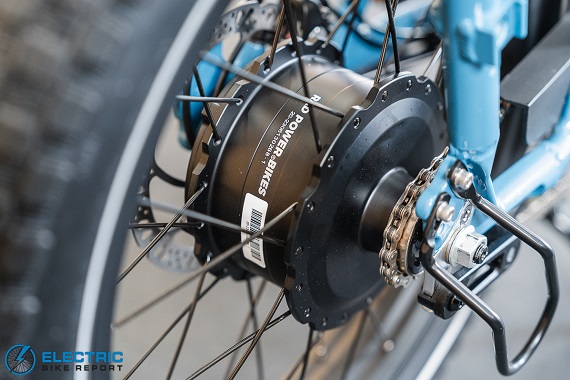
The bike’s 750W motor provides steady and consistent power.

The bike’s rear rack can hold up to 120 lbs and is compatible with a huge range of accessories!
Rad Power Bikes RadRunner 2 Review: Speed Test
Here at Electric Bike Report, the first test we perform on an e-bike is a Speed Test, which allows us to get a feel for the power level of each pedal assist system (PAS) setting and the overall programming of the bike. Our test course is a segment of our local bike paths, where we pedaled the RadRunner 2 first with no pedal assistance before moving through its four PAS settings.
The bike’s sizable 53T chainring made pedaling solely with leg power fairly tough; we recorded a max speed of 10.9 mph with our average running around 10.5. We found that the bike’s lowest assist setting, PAS 1, provided a subtle amount of power that removed the resistance from the chainring and made pedaling more comfortable – we reached 11.5 mph in this setting.
The bike’s speed/power distribution from PAS 1 through PAS 3 was ideal, showing measured, consistent increases. Our maximum speed in PAS 2 was 15.4 mph, which raised to 19.5 mph in PAS 3. Interestingly, we observed no difference in maximum speed using PAS 4, though we learned that there was, in fact, a measurable difference when pedaling uphill – more on that later in the Hill Test section of this Rad Power Bikes RadRunner 2 review.
For ease of use, we like that the bike comes with just four PAS settings; five typically feels too incremental on a Class 2 e-bike like the RadRunner with a maximum motor-assisted speed of 20 mph. The bike’s programming takes this a step further by essentially giving riders three practical settings for flat ground and a fourth for climbing hills or carrying cargo.
This speed/power distribution gives riders flexibility in their ride feel. In PAS 1, the RadRunner 2 feels more like a non-electric bike. PAS 2 provides a moderate level of power for casual, leisurely rides; I spent most of my time on the bike in this setting. PAS 3 is for those who prefer more speed, allowing riders to reach the Class 2 limit. And PAS 4 provides additional power for more demanding situations.
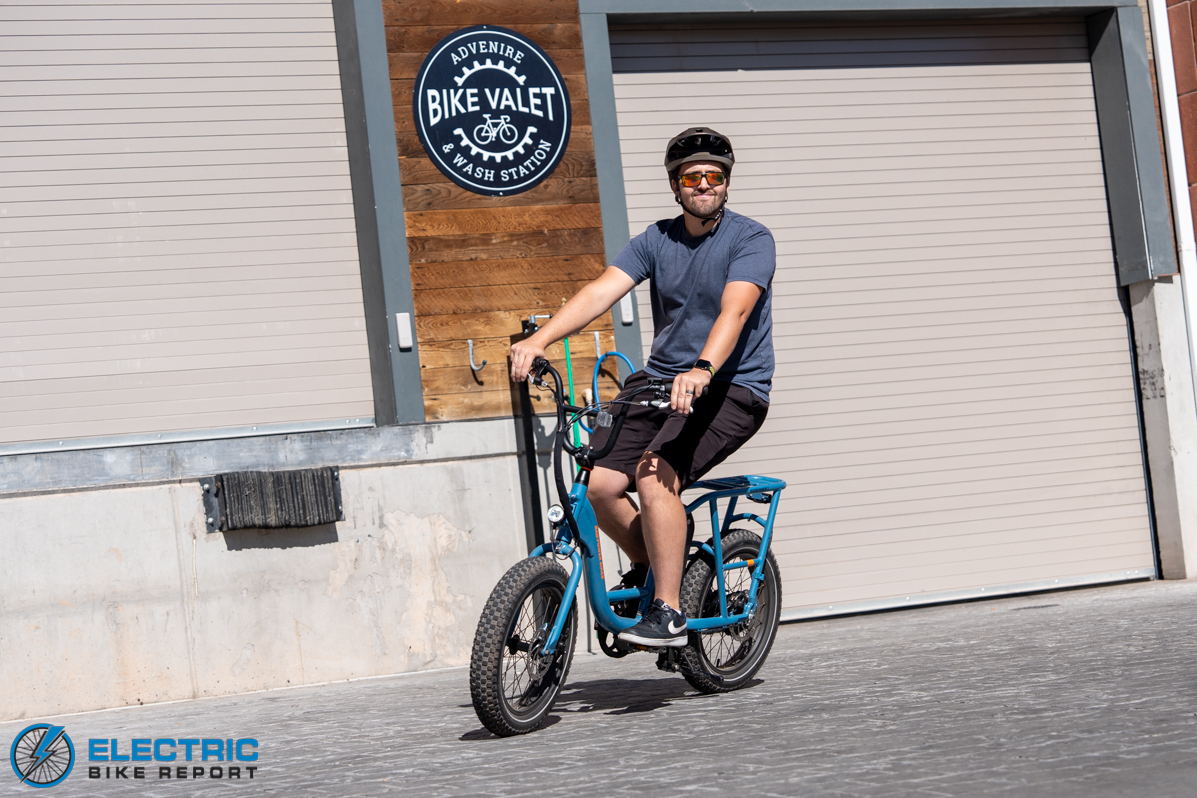
With small 20” wheels, the RadRunner 2 has great handling and maneuverability.

The 53T-16T single-speed drivetrain felt well balanced when climbing hills and riding at speed.

The battery’s placement behind the seatpost keeps the bike’s weight balanced.
Rad Power Bikes RadRunner 2 Review: Range Test
To evaluate the RadRunner 2’s range and the efficiency of its motor/battery pairing, we pedaled the bike along our local network of multi-use paths until its battery expired. We performed two separate tests – one with the maximum amount of pedal assistance in PAS 4, and another with the minimum practical level of power which we determined to be PAS 2. We made this determination based on the results of our speed test which showed a max speed of 11.5 mph in PAS 1.
We recorded between 32.7 and 42.7 miles on a single charge, which – as expected – lines up well with our test of the 2022 version (31 to 46.7 miles). Riders using even less power in PAS 1 could expect to travel farther, though there is a tradeoff in terms of speed.
Since we used what is essentially the bike’s middle PAS setting for our low-power test, the bracket of results we measured was narrower than we’ve experienced on other e-bikes with more “juice” in PAS 1, but the RadRunner 2 still performed well. Its PAS 2 results were on the lower end when compared with similar e-bikes we’ve tested, but the bike’s battery capacity is also on the smaller side. The bike’s PAS 4 results were on par with our results from similar e-bikes despite many of those having larger batteries.
In truth, the bike proved to be significantly more efficient than we expected! Based on its motor and battery specs, we anticipated our PAS 4 test to last just under an hour with a result of around 17.5 miles. With our results of nearly two hours, we measured nearly 104% more time on the bike, and with a real-world range of nearly 33 miles, we covered nearly 87% more distance than expected.
While those carrying additional weight on the cargo rack should expect less mileage than we measured, we consider the RadRunner 2’s range to be highly practical for what are likely to be the bike’s main uses. Running errands, short family trips, and even commuting to and from work should all be completely achievable with the results we measured.
Rad Power Bikes RadRunner 2 Review: Hill Test
Our Hill Test, explained in the graphic above, is a true test of an e-bike’s motor. The steep, paved path at Hell Hole Trail can be intimidating even with a motor, making it a perfect testing ground to measure raw uphill power.
In our first trial using solely throttle power, we reached the top of the path successfully in 1 minute and 41 seconds, maintaining an average speed of 10.7 miles per hour. This result is certainly on the slower side when compared to similar e-bikes from other brands, though it is the best result we currently have from a Rad Power e-bike.
The RadRunner 2’s results improved in our second test using the maximum amount of pedal assistance in PAS 4, though it stuck to a similar pattern. Comparatively speaking, it was once again relatively slow but steady; we reached the top of the hill in 1 minute, 30 seconds, with an average speed of 12.1 mph.
In our experience, Rad tends to tune down their motors to provide a steady and less-punchy feel. This keeps their bikes feeling reserved, consistent, and safe, but still quite capable; in the case of the RadRunner 2, the motor’s 750 watts of nominal output was more than adequate to conquer Hell Hole. Technically speaking, the RadRunner 2 may even have slightly less power than some of its competitors; Rad keeps the power-to-ground wattage of their motors under the legal limit of 750W to be compliant with e-bike regulations.
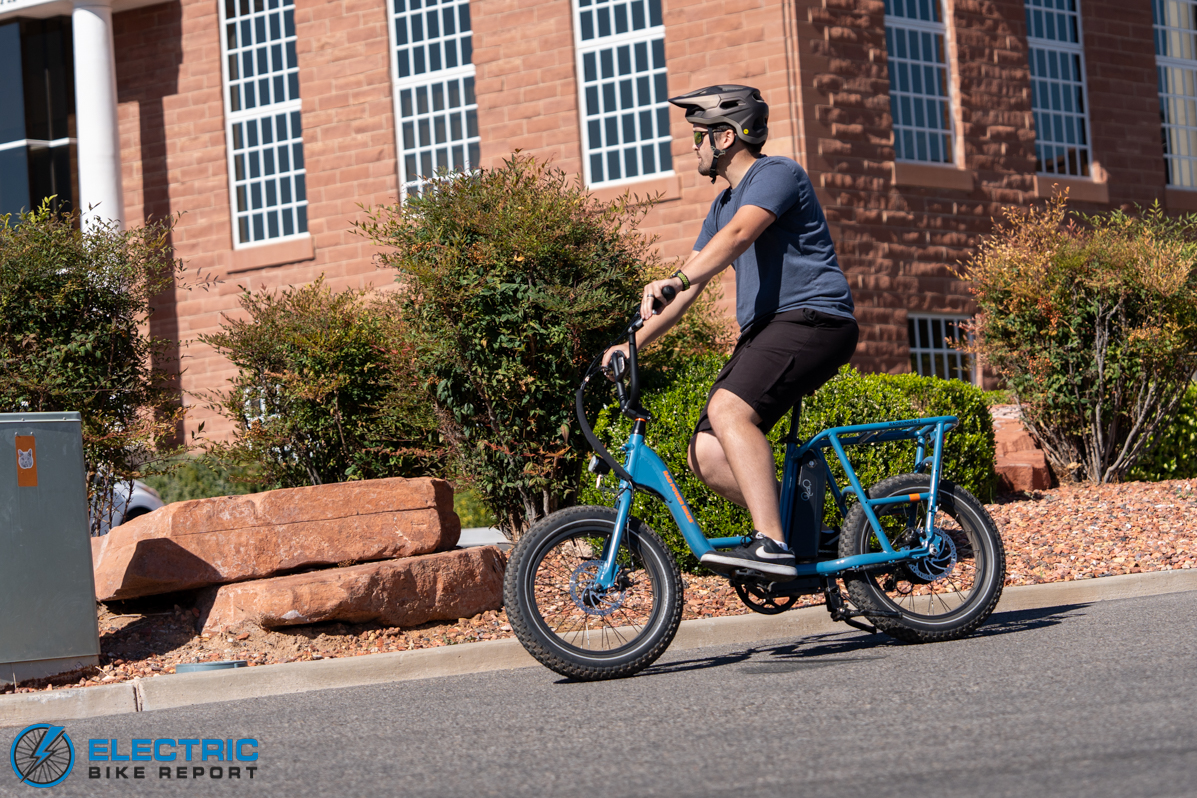
The RadRunner 2 fits riders from 4’-11” to 6’-2” with a single frame size.

We were impressed by the performance of the Tektro Aries mechanical disc brakes!
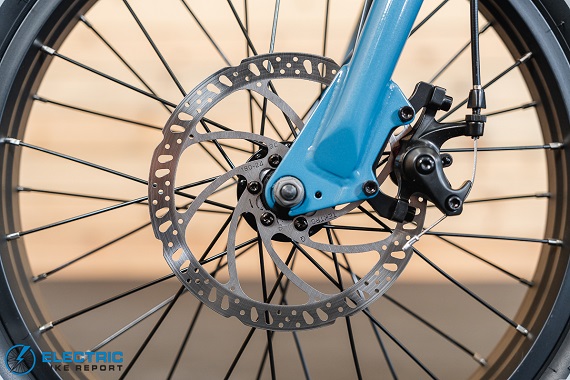
The brake system uses 180 mm rotors on both wheels.
The bottom line is that the RadRunner 2 is not the fastest climber we’ve tested, but as in the story of the tortoise and the hare, slow and steady might just win the race.
To take a detour from our official Hill Test, I performed a separate evaluation of the bike’s hill climbing ability to confirm that there was a difference in power output between PAS 3 and 4 following the results of our Speed Test. I tested the bike by pedaling in both settings up another steep and challenging local hill, and recording those results. In PAS 3, the test took 1 minute and 40 seconds to complete, and I maintained an average speed of 12.0 mph. The added power of PAS 4 reduced my time to 1 minute and 18 seconds with an average speed of 15.4 mph.
Despite their identical Speed Test results on flat ground, this separate evaluation showed a 22% decrease in time with a 28% increase in speed between PAS 3 and 4. Thus, the bike was capable in both settings, but clearly utilized more power in PAS 4.
Rad Power Bikes RadRunner 2 Review: Brake Test

Using the process explained above, we evaluated the performance of the RadRunner 2’s Tektro Aries mechanical disc brakes, which use 180 mm rotors. The average stopping distance calculated from the bike’s three test results was an impressive 19’-8”.
This result is excellent! In most cases we are advocates for hydraulic disc brakes; while usually more expensive than mechanical brakes, they often provide more responsive stopping power. In the case of the RadRunner 2, however, the mechanical brake system it is specced with significantly outperformed many hydraulic systems on similar e-bikes we’ve tested.
Our current running average for the utility e-bikes we have reviewed is 20’-9”, which shows that the RadRunner 2 performed better than average by 13 inches. This difference is not monumental, but it is significant, and is likely due to the RadRunner 2’s relatively low weight. The bike weighs approximately 65 lbs including its battery, which is 10-20 lbs lighter than many of the similar e-bikes used for comparison.
With a lighter frame, the RadRunner 2’s carrying capacity may be slightly below some of its competitors, but it also requires less effort to slow down. The Tektro Aries brake system is economical but still clearly appropriate for the bike; it’s effective, easy and inexpensive to maintain, and helps to keep the overall cost of the RadRunner down.

The 686-mm high-rise handlebars have an ergonomic sweep to the handlebars for comfort and easy steering.

The bike includes an LED headlight and a tail light with brake light functionality.

The bike’s standard saddle felt fine for short rides but is one thing we recommend swapping out.

The included chain guard was a small but appreciated detail that kept our pants clean.
Rad Power Bikes RadRunner 2 Review: Ride Quality
In terms of comfort, the bike would be ideal were it not for one element. The bike’s upright and ergonomic riding position felt comfortable and natural, allowing for long rides without fatigue. The slight sweep of the high-rise handlebars and its ergonomic grips were similarly enjoyable. The bike’s saddle, however, is something that we challenge Rad to improve; the majority of our testers found it to be somewhat blocky and awkward-feeling. Fortunately, Rad offers a variety of compatible saddles which we recommend in place of the standard model.
The RadRunner 2 is offered in just a single frame size, but it is accommodating for a wide range of riders. With 13.25” of adjustment in saddle height, the bike can fit riders between 4’-11” and 6’-2”. While its stem is relatively low, the included handlebars can be rotated to adjust rider reach and comfort. Extremely tall riders may wish to swap for a taller set of handlebars to raise their hand placement, but the stock bar should work for most.
The bike’s overall ride feel was solid. With a cadence sensor that activated the motor quickly and the previously-mentioned four PAS settings, we had the option to engage in active pedaling or relax into ghost pedaling with a more casual pace.
Bumps were noticeable due to the absence of any suspension on the rigid frame, though they were softened somewhat by the custom 20” x 3.3” Kenda fat tires. This wheel size gave the bike great handling and maneuverability, and the checkerboard tread pattern worked well on pavement. The bike could be taken on very light off-road adventures, but we recommend reducing tire pressure to add cushion and grip.
In general, the RadRunner 2 was incredibly easy to operate. Some ghost pedaling was a natural side effect of the single-speed drivetrain when moving at high speeds, and starting from a complete stop could be tricky without the throttle, but most of the time we didn’t notice the absence of a cassette, a derailleur, and a shifter.
The bike’s cockpit is simple as a result of these intentional exclusions; with no LCD and no shifter, the only controls aside from the brake levers are those for PAS adjustment and lights on the button panel on the left handlebar. This panel uses LED lights to indicate PAS setting, battery charge, etc. which we appreciate for ease of use. Riders who prefer access to ride data will need to use a third-party app or purchase an optional display separately. Rad seems to have taken feedback from this seriously – the RadRunner 3 Plus we reviewed upon its release included two displays!
Accessories, however, are a strong suit of the RadRunner 2. The base model includes basics like a headlight, tail light with brake light functionality, a bell, and even a greatly-appreciated chain guard. There are currently over 50 additional optional accessories including cargo baskets, bags, panniers or bins, passenger seating and security, Thule Yepp Maxi child seats, fenders, saddle options, a suspension seatpost, and more.
Ultimately, we think the basic RadRunner 2 is solid on its own, but with such a massive range of accessories (330 possible combinations, according to the brand), owners can completely customize their bike to suit the needs of their lifestyle and family. This helps to reinforce the ethos of Rad Power Bikes, whose mission is to encourage individuals to rely more on a bike instead of a car. With such a vast array of options to expand the RadRunner 2’s functionality, there is no wonder it is such a popular bike.

The RadRunner 2 uses a small button panel with LED indicator lights instead of a display screen.
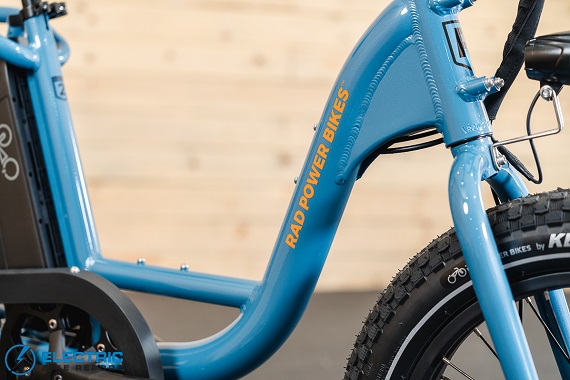
The limited Pool Shark Blue color used glass crystal pigments that are more visible at night.

The custom 20”x3.3” fat tires are made in partnership with Kenda and use a unique tread pattern.

The half-twist throttle felt fitting considering the moped-influenced design of the bike.
Rad Power Bikes RadRunner 2 Review: Summary / Where to Buy
In true Rad style, the RadRunner 2 is a thoroughly well-thought-out machine. The brand made improvements on the subsequent iteration of the bike, but this version retains a certain nostalgia in addition to its solid performance and affordability. In our opinion, the RadRunner 2 is a fantastic, highly versatile, and hugely functional e-bike that successfully fulfills Rad’s mission to, at least in some part, replace cars with bikes.
Despite the upgrades the brand made on the RadRunner 3 Plus, we still think there are a couple of minor areas worth improving on the RadRunner 2 – or at least things prospective owners should be aware of. Neither the saddle nor the absence of a display were deal breakers, as there are optional accessories and apps to remedy our concerns, we just wish some of those things didn’t require an additional purchase.
Additionally, we hope Rad decides to keep the new paint job (the color appeared spontaneously after we suggested brighter colors to the CEO) because it just looks so good!
But realistically, the RadRunner 2 has been one of our most recommended e-bikes since we reviewed it in 2022, and we don’t see that changing. It is truly a do-it-all e-bike at an entry-level price, backed by the experience and thorough approach of a big name in the industry.
Happy Riding! Make sure to let us know if you have any questions or if you think we left anything out in this review of the Rad Power Bikes RadRunner 2 down in our comments section.




How come my comments are lost? I’m not selling anything….